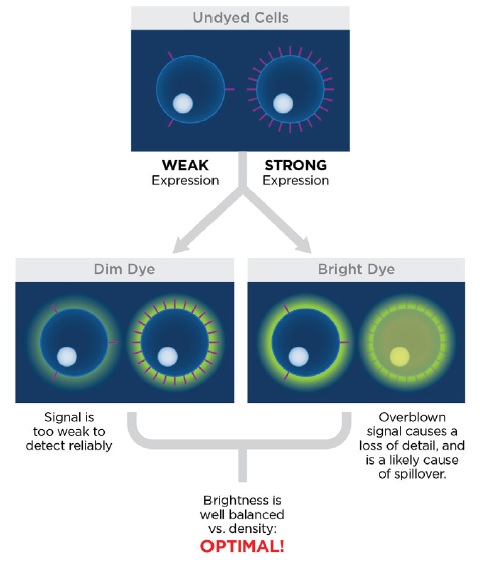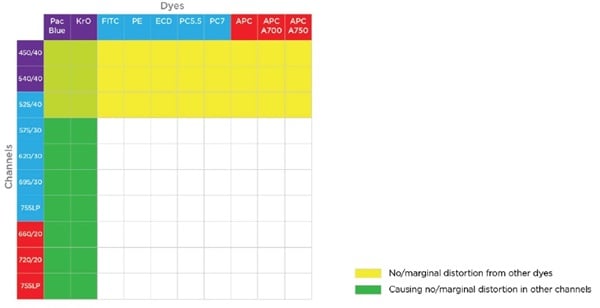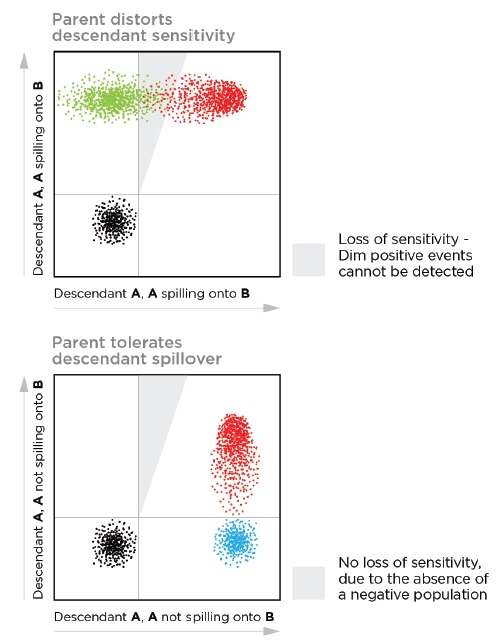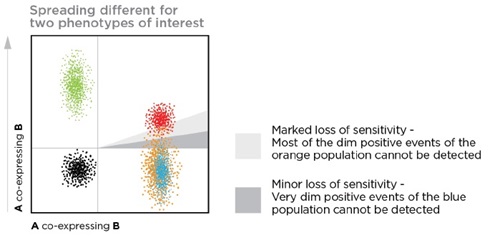Seven Tips for Achieving the Perfect Panel for Multicolor Flow Cytometry
1. Fluorochrome Selection
Not all dyes are created equal! Some dyes are extremely bright, while others are vanishingly dim in comparison. However, choosing the brightest dye is not always the brightest idea, and avoiding a dimmer dye is not always prudent. In general, it is advisable to use a dye that is sufficiently bright to detect the antigen of interest while causing the least spillover or bleed into other detectors. Spillover occurs when the emission spectrum of one fluorochrome is detected by a detector set to measure the emission of a different fluorochrome, thereby contributing to unwanted signal in the channel of the second fluorochrome. Brighter emission means more potential for spillover and more data spreading, which can lead to a loss of resolution. To avoid this, use brighter dyes for weakly expressed antigens and, conversely, use dimmer dyes for strongly expressed antigens. Following this rule will allow you to democratize your dyes!

2. Channel selection
Let’s face it, spillover happens, but you can still optimize your selection of dyes for your panel – Choose fluorochromes with reduced influence on other channels for strongly expressed antigens (green columns), while assigning weakly expressed antigens to fluorochromes whose detection channel is only slightly impacted by spillover from other fluorochromes (yellow rows). Whether a fluorochrome falls into one of the above categories will depend from the instrument configuration and the choice of fluorochromes. Be sure to test fluorochrome and channel combinations to find the best lineup for your panel.
It can be challenging to avoid spillover when designing experiments that make use of all available channels, but these tips can help you to reduce the impact that spillover will have on your panel and the resulting data.

3. Antigen Exclusion
What’s a little spillover between mutually exclusive antigens? Spillover between the emission spectra of two antigens won’t interfere with your panel if the antigens are not expressed together on the same cells in the cell gate of interest.
4. Antigen co-expression
If a marker typically or potentially has a modulated or weak expression density, you should try to reduce spillover from co-expressed antigens’ fluorochrome labels into this marker’s channel, as spillover can occlude your data and a mask potential modulations. Only spillover from non-co-expressed antigen fluorochrome labels is safe, and will not impact sensitivity and resolution for modulated or weakly expressed antigens.
5. Parent-descendant
Talking back to your parents isn’t always a bad thing? For multicolor flow cytometry panels, descendants talking back to their parents can preserve sensitivity between markers. Translation: you can allow a sub-set or sub-population (descendant) marker to spill over onto or crosstalk with the gating marker (parent). The parent marker will tolerate this spillover since the descendant will always be positive for the parent marker. For example, if CD4 shows a strong spillover in the CD3 channel within a lymphocyte gate, the background spreading will not cause background spreading in the CD3 channel because the CD4+ T-cells are also CD3+. Watch out for the converse conditions, where the parent marker has crosstalk with the descendent marker, because the parent signal’s spillover will contaminate the background of the descendent signal.
6. Positive Threshold
Spillover to a co-expressed antigen is permissible if the goal is only to identify brightly positive cells, or to discriminate between bright and medium-strong/dim expression. However, spillover cannot be tolerated when the goal is to discriminate between dim and negative expression only, as this will cloud your data and conclusions, resulting in false positives.
7. Spillover Complexity
Kiss complexity goodbye, and try to keep the spillover patterns as simple and straightforward as possible to avoid phenotype-dependent detection limits. Remember, however, that there will be spillover and spreading from fluorochromes that are not shown in your dot plot, so “keeping it simple” may be pretty complicated!
Keep these 7 tips in mind as you plan your next multicolor flow cytometry assay, and your panel will reward you with optimum signal detection and increased certainty of results with reduced complexity. To further improve your odds of success with multicolor flow cytometry, use high quality and robust reagents that have undergone the scrutiny of regulatory agencies and manufacturing standards.
The more reliable your reagents, the more reliable your data!

